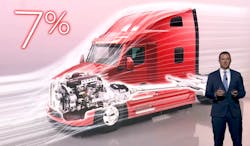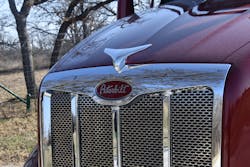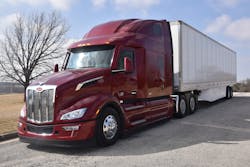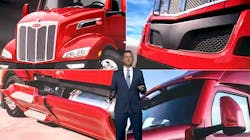Peterbilt’s Skoog talks new Model 579, future technologies
For four consecutive months, Class 8 truck orders have exceeded 40,000 units per month, and according to preliminary data from FTR Transportation Intelligence, orders for the last 12 months total 308,000.
Jason Skoog, general manager of Peterbilt and vice president for Paccar, told FleetOwner that based on current forecasts, Paccar anticipates continued growth – not just replacement of current units – in 2021. Overall, Skoog projects that 2021 is going to be a “great year for truck build.”
Now, Peterbilt has its own news to bring to market. The OEM kicked off 2021 on a high note with the launch of its thoroughly redesigned on-highway flagship, the new Model 579, on Feb. 3. Billed as the most technologically advanced truck the company has ever built, the new Model 579 is also the most aerodynamic and fuel-efficient Pete—providing a 7% improvement in fuel economy when spec’d with the next-generation Paccar powertrain—to go along with substantial improvements in uptime and driver comfort.
Skoog and other company representatives revealed the newest Peterbilt in a YouTube livestream on Feb. 3. “I am really proud of how the new 579 turned out,” Skoog told FleetOwner. “We did this big thing on YouTube live and it was exciting. I enjoyed every second of it. It was just great to be able to unveil something to the trucking population.
“I am excited for it to get out there to our dealers’ lots so they can demo it with our customers,” he added. “That’s going to be happening as we start going into full production here. I truly think our customers are going to benefit from it.”
The new Model 579 goes into production in April, during which time Peterbilt will still build both the current Model 579, which was originally introduced at the Mid-America Trucking Show in 2012, and the new Model 579 side by side. By mid-July Skoog said the new Model 579 will be in full production.
FleetOwner recently sat down with Skoog to discuss not only the rollout of the new Model 579, but also 2021 and beyond projections for Class 8 builds, as well as the evolution of future truck technologies.
FleetOwner: Regarding the recent full redesign of the Model 579, some would suggest Peterbilt is the quintessential brand when anyone thinks of trucks. With that legacy you’re looking to uphold, how has Peterbilt worked to balance fuel efficiency and next-generation technologies while still honoring the heritage of the trucks you’re producing?
Jason Skoog: The way I think about it is that when you see the truck, you want someone’s first impression to be, “That’s a Peterbilt.” That’s what we were going for here. I think we really took advantage of some of the styling opportunities we had as we were going through this redesign. The thing that is quintessential about Peterbilt is the Peterbilt “bird” that sits above the crown and the red oval—it’s on every one of our trucks. The look and shape of that bird is really taken throughout the new Model 579. We were very intentional when we launched the UltraLoft (Model 579) sleeper in 2018. We knew this was coming, so we are really just marrying everything together, and we are really paying homage to that tradition of the bird.
For people who spec the LED headlights and have the daytime running lights set, that signature look is not a Peterbilt signature look today, but looking into the future, I would like anyone, any time they see that daytime signature running light to think, “That’s a Peterbilt.”
We paid homage to the past, but we’re also creating a signature look for the future as well.
FO: While we’re still dealing with the ramifications from the COVID-19 pandemic, what kind of market demand are you expecting for Class 8 truck orders in 2021? Are you experiencing any challenges when it comes to supplier and material shortages, especially as freight growth continues to be vibrant and fleets might be rushing to add capacity?
JS: The demand for Class 8 trucks really started four months ago. The fourth quarter was really strong for Class 8 truck orders with 138,000 orders (industrywide), and then we saw right around 40,000 units ordered in the month of January. The last time you saw orders at that level over the same period was the beginning of 2018.
Now, I am not predicting the future that far out, but what those orders tell me is that 2021 is going to be a great year for truck build. The current Paccar forecast is between 250,000 and 280,000 trucks for the year. That’s above replacement demand, and while we’re seeing customers replace trucks, we’re also seeing growth as well.
Then you look at what COVID has done to inventory levels, which are extremely low across the U.S. in all different industries. There is a big inventory restocking going on, along with strong moves to e-commerce and strong reports of retail sales. So, there are just a lot of tailwinds really set up for the truck market to have a good year.
Regarding supply chain, I don’t think it matters whether it’s COVID or any other time. There is always a consideration for the supply chain as we go up in build—I think most people are probably going up in build right now based on the pace of the order intake. For Peterbilt, it’s just always about working hand-in-hand with our suppliers, constantly communicating, giving plenty of notice for when we are going to take our build rate increases up, and just working with them to meet demand. That’s not to say there is never going to be a shortage, but even when [shortages] do crop up, we handle them quite well and we’re able to deliver.
FO: When it comes to spec’ing trucks, what insight have you gained from customer feedback, and how has that driven the direction of future product advancements—not just with this new Model 579, but also other products that you’re working on in your portfolio? How is Peterbilt helping fleets map out their asset planning and management to address these changes?
JS: One of our brand tenets is customized solutions. Every customer’s application is unique. You can say an on-highway truck is an on-highway truck is an on-highway truck, but that’s not necessarily the case. Cruise speed, average road speed, and many varying factors go into how to get a truck spec’d so that it’s going to deliver the maximum fuel economy for whatever routes it’s on.
As software becomes easier to customize for each individual customer and situation, whether it’s engine software or transmission software, the more you’re able to dial in to their specific needs. Understanding what options we have now, what customers are asking for, and then how we meet those requirements is really how we think about product development.
FO: What are some of your top goals, as a brand for Peterbilt and at Paccar overall, that you hope to achieve in 2021? What about farther out over the next five years or so?
JS: With the launch of this truck, Peterbilt already has a wide portfolio of products that we offer for our customers. To me, this just takes our on-highway product offering to the next level. When I think of that, I am thinking of if this truck is going to deliver additional fuel economy benefits, if it’s going to be better for the driver due to the digital display and if it’s going to be quieter in the cab, as well as so many aesthetic changes we made inside the cab. I think of always trying to improve the product day in and day out. When I think of all those things, my hope is that when we get to the end of this year, we have a nice increase in market share. Every OE is going to start the year saying we want to increase our market share—that’s just how everybody thinks. If I wake up on Jan. 1, 2022, I’m thinking we should have higher market share. And this truck is going to drive us there.
Five years from now, it’s obviously hard to look out that far into the future, but Peterbilt has been around for over 80 years now. When I look at the 2000s and the 2010s, we grew our market share by a significant amount in the difference between the first decade and the second decade of the 2000s—we are 1.5% to 2% higher than we were. As I think to getting to the middle of this decade, I think growing a point to two points a share is very realistic. When you look at this truck, that’s the truck that’s going to get us there.
Our goal is not just to grow share for the sake of growing share but doing it because our customers recognize that the trucks we have out there will deliver them the lowest total cost of ownership (TCO).
FO: There are two camps—electrification and vehicle autonomy—and discussion about how one technology will see widespread adoption before the other. Do you have any insight as to how development of those technologies are both working in conjunction with one another, and do you anticipate one happening before the other in the industry?
JS: I think you have to look at them both independently. Electrification really speaks to the future of powertrains. Autonomous can be put on an electric powertrain, a diesel powertrain, it can be integrated into really any powertrain. So, taking a look at one over the other and saying this one is going to get here first, I don’t know that it matters.
When it comes to electrification, we’re talking about the next couple of years across the industry, sales will be in the hundreds. I don’t think you’re going to see a transition to sales in the thousands until 2023, and then 2024 is really when you’ll start to see a significant gain—maybe in 2024, the industry will start selling 10,000 units a year. And that’s going to be driven off the regulations that have already been announced by CARB (California Air Resources Board). That’s really going to drive that mid-20s adoption in those sales figures.
From there, you’ll start to see costs come down because you’ll see greater scale. For 2024 emissions on the diesel side, you’re probably going to see costs go up. Then, you’re going to have more infrastructure available on the electric side, which is going to make it easier to charge. So, you’re going to see a convergence of things where maybe an electric vehicle is still more expensive at that time, but when you do a TCO or an ROI calculation, electric can make more sense as we proceed throughout the decade.
On the autonomous side—someone asked me earlier will autonomous vehicles happen? The answer is, ‘Yeah, they’ll happen. Just don’t ask me when.’ It’s just one of those things where the technology is going to be there before the other three most important parts are there: Regulation to see where you can do it, the legal ramifications, and then everyone in the public has to be OK with a semi-truck driving down the highway with nobody behind the wheel.
FO: Can you speak to data collection and how that is going to impact future technologies for commercial vehicles? And, more specifically, for the fleets that are looking at that maximum uptime, how will autonomous vehicle technology drive those changes as well?
JS: Every truck we produced since 2015 has a modem on it, and that’s what drives the remote diagnostics today and what’s also driving over-the-air software updates today. In the future, it will provide the ability to change parameters in the engine and over-the-air. But as part of that, there is nonstop data collection going on, and we’re using that data collection to look at how trucks are performing, and we know the exact status of every single truck that is out there.
Then, when you start to apply things like machine learning and advanced analytics, you get to the point where you’re going from reactive to predictive on the maintenance side. In talking to people, being able to get to the point where you’re predicting the truck is going to have a service event before it actually has the service event, that’s really the point where we want to get to because that’s going to add a tremendous amount of value.
FO: To add to that, if you don’t have a driver or there is no operator in the vehicle, those sensors then can also provide that insight.
JS: I always wondered in the case of an autonomous truck breaking down, what are you going to do? You’ve got to send a wrecker out for it, probably. Those are all things that as more and more autonomous trucks roll out, and when we get to that point where we can predict things instead of reacting to them, I think that’s going to be a key enabler of autonomous vehicles. You’ll have to be able to predict the future so that you don’t have those situations where the truck can’t move and it’s in the middle of the highway.
About the Author

Cristina Commendatore
Cristina Commendatore is a past FleetOwner editor-in-chief. She wrote for the publication from 2015 to 2023.
Erica Schueller
Editorial Director | Commercial Vehicle Group
Erica Schueller is a former editorial director of the Endeavor Commercial Vehicle Group.




